Qingzang Railway Stations
The Qingzang Railway, also known as the Qinghai-Tibet Railway, is the only rail route from mainland China to Tibet, and runs for 1,956km from Xining to Lhasa. There are 45 stations along the route, and each has its own unique scenery, including Amdo Railway Station, Bayan Railway Station, Damxung Railway Station, Ganzihe Railway Station, Geermu East Railway Station, Golmud Railway Station, Haergai Railway Station, HaiyanDashi railway station, Haiyan railway station, Hangya Railway Station, Huangyuan Railway Station, Ketu Railway Station, Lhasa Railway Station, Lhasa West Railway Station, Naqu Railway Station, Qinghai Lake railway station, Shenzhong Railway Station, Shiyazhuang Railway Station, Shuangzhai Railway Station, Tanggula Railway Station, Tuole railway station, Wudaoliang Railway Station, Wulan Railway Station, Xining West railway station, Xining Xiaoqiao railway station, Yuejiacun railway station, etc.
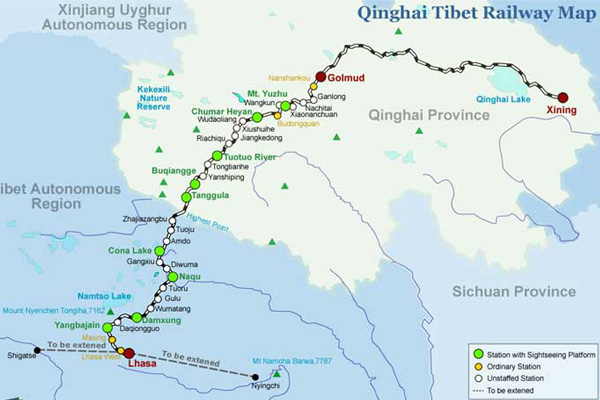 This map shows the main stations along Qinghai-Tibet Railway.
This map shows the main stations along Qinghai-Tibet Railway.Six of the 45 stations along the Qingzang Railway are major stations and important stops for both passengers and freight trains. While the trains might not all stop at the other stations, depending on the train taken, all of them stop at these major stations for a short time, and each has its own unique features.
Xining Train Station
Located in Qinghai Province of China, Xining Railway Station is the starting point of the Qingzang Railway at an elevation of 2,275 meters. It is the first major station along the route to Tibet, as well as being an important railway hub for trains in other directions. All trains, from every part of China, stop at Xining, and passengers can board any train with space that passes through. However, as the train from Xining has more carriages and seats than any other train, it is best to get the Tibet train from Xining, as there is a better chance of getting tickets.
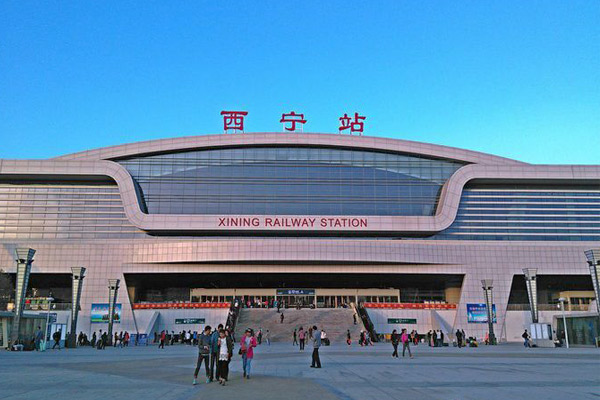 Xining Train Station
Xining Train StationThe station is located on Huzhu Road, in Chengdong District, and was first opened in 1959. For a time trains ran from the Xining West Station, until refurbishment of the main station was completed in December 2014. Once it was reopened, all Tibet trains start from Xining Station again, and Xining West was closed. After the station was expanded and refurbished, the surrounding area became an urban business district with many offices and other integrated services. Travel to the station from anywhere in the city takes just 5-10 minutes, and costs just 10CNY for a taxi or 1CNY for a bus.
The newly rebuilt station boasts the best in modern facilities, with waiting areas for different classes of tickets, LED display panels for passenger information throughout the station, and it even has a market for shopping before your trip.
DelinghaTrain Station
521km into the trip to Lhasa is Delingha Station, the first major station along the route, at an elevation of 2,980 meters. Built in 1979, the station is now classified as a third-class station and comes under the administration of the Qinghai-Tibet Railway Company. Delingha Station is located in Delingha City, and is part of the Haixi Mongol and Tibetan Autonomous Prefecture in the north of Qinghai Province.
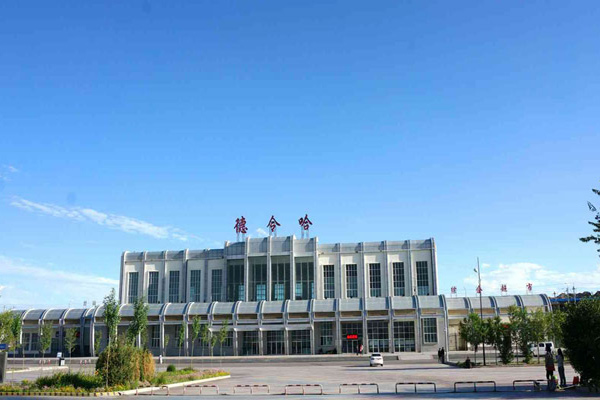 Delingha Railway Station
Delingha Railway StationThe name Delingha is a Mongol word that means “Golden World”. The city is the capital of the Prefecture, and is an educational, technological, and cultural center. It is also the center of the Haixi Economic Region. While this is one of the major stops for the Qingzang Railway, the train from Xining only stops here for around 6-8 minutes, so there is little time to get off and stretch your legs.
Golmud Train Station
Sitting at an elevation of 2,829 meters, Golmud (Geermu)Railway Station is the closest city in inland China to Tibet Autonomous Region. The second biggest city in Qinghai Province, Golmud is a mining town, built up around mineral mining such as salt and magnesium. For tourists, there is nothing to offer in the area except arid desert, although the train stops for long enough to get out and stretch your legs after 7 hours of traveling. The 20-25 minute stop is refreshing, but only passengers with tickets ending at Golmud may leave the station.
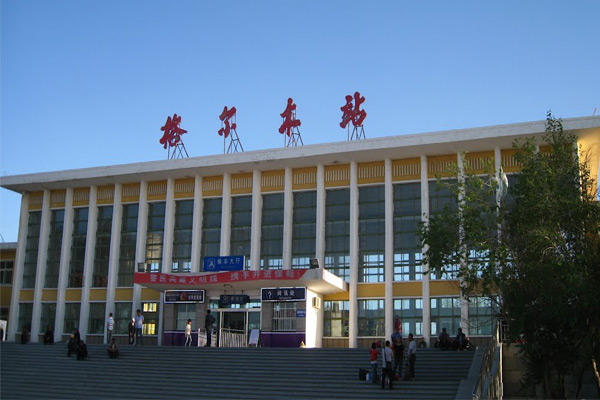 Golmud Railway Station
Golmud Railway StationThe station is 830km from Xining, and is a modern building that is clean and well kept, as are all stations along the route. The waiting area is large and train schedules are clearly displayed on the Led screen at both ends of the hall.
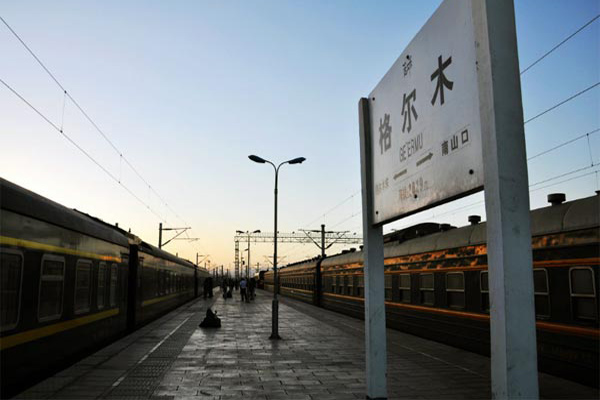 Golmud Railway Station Platform
Golmud Railway Station PlatformOn leaving Golmud, the train starts its real upward journey to the Qinghai-Tibetan Plateau, and all trains turn on the internal oxygen systems on leaving Golmud, to make the trip more comfortable for the passengers, and reduce the chance of altitude sickness as the elevation increases.
Amdo Train Station
Amdo Railway Station is the largest passenger and freight train station in Tibet, at an altitude of 4,702 meters above sea level. The station is designed in the form a traditional Tibetan “yurt”, which is a round, domed tent made from animal skins and bamboo frames, which is used by Tibetan nomads. The station is large; covering an area of 140,000 square meters, and has clear views of the Changtang grasslands, which surround it. The train stops for 5-6 minutes, which is enough time to get a better view of the grasslands from the platform, and take a few photos.
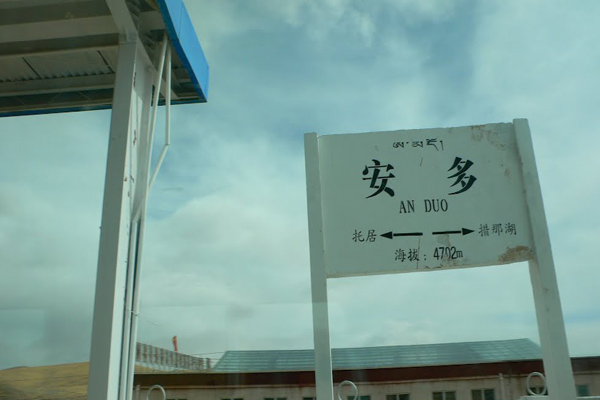 Amdo Train Station
Amdo Train StationAmdo is one of the three traditional regions of Tibet, the other two being Ü-Tsang and Kham. The people of the region were traditionally either drog pa (nomads) or sheng pa (farmers), and the entire area is agricultural.
Damxung Train Station
The last major station before Lhasa, Damxung sits at an elevation of 4,288 meters, and the train only stops for 2-3 minutes before leaving. The station is a low, single story building along the same lines as Amdo Station, and is only 166km from Lhasa.
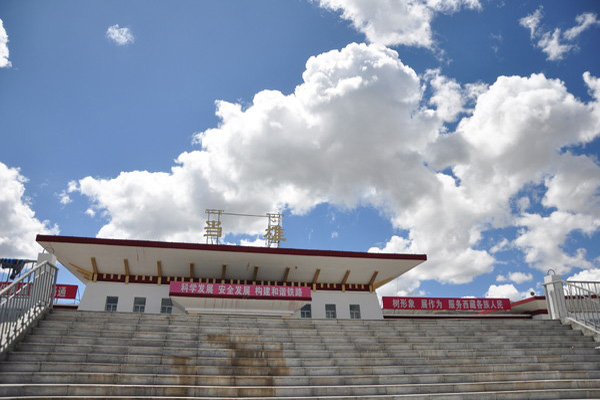 Damxung Train Station
Damxung Train StationThe area of Damxung is relatively modern, and is important in the region for general supplies and government functions. Nearby lies the sacred Lake Namtso, the largest lake in the Tibet Autonomous Region, which contains five uninhabited islands that are often used as spiritual retreats.
Lhasa Train Station
Lhasa Railway Station, at an elevation of 3,641 meters, is the end of the line for the Qinghai-Tibet Railway. The largest station on the line, Lhasa Station covers an area of 23,600 square meters, and includes seven platforms serving 10 tracks. It is a three-story building that mixes traditional and modern design, with two floors above ground and one below.
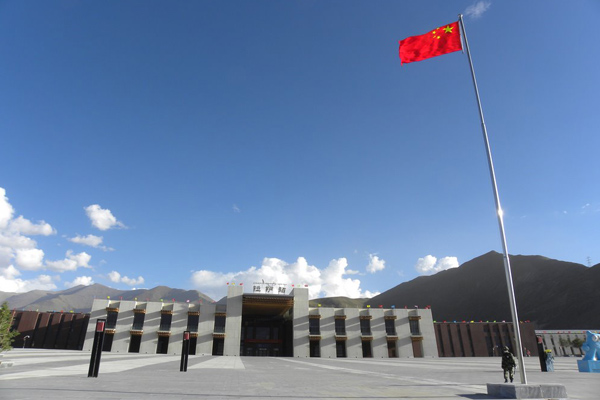 Lhasa Train Station
Lhasa Train StationThe station sits on the south bank of the Lhasa River, and is around 5km from the center of downtown Lhasa. With multiple waiting rooms for different ticket classes, and a large main hall, the station serves around 2,700 passengers a day. Arrivals disembark from the trains on the underground floor, and make their way up to the ground floor, where they can get buses or taxis to the city, or buses to other areas of Tibet.
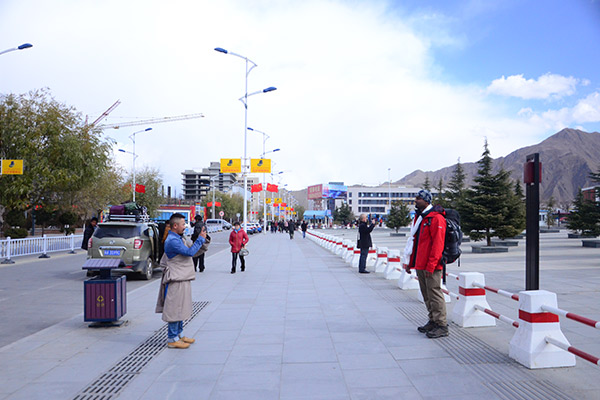 Upon arriving at Lhasa Railway Station, out Tibetan local tour guide will pick you up.
Upon arriving at Lhasa Railway Station, out Tibetan local tour guide will pick you up.Our tourists will meet their drivers and guides at the entrance to the main hall, and be taken to the waiting transport at the west side of the station. Vehicles are not allowed within 150 meters of the main building.
The station is set against a backdrop of the surrounding hills, and is an imposing structure in an even more imposing landscape. From here, it is a short ride to downtown Lhasa, and some of the most spectacular Buddhist sites in the world, such as Potala Palace and Jokhang Temple.
 BACK
BACK




0 Comment ON "Qingzang Railway Stations"